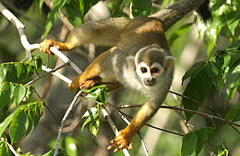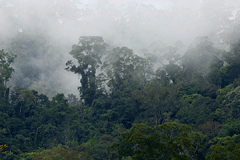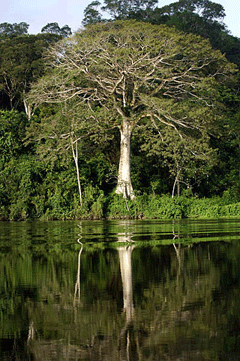Conserving the Rainforest
Air Date: Week of December 15, 2006

Squirrel monkey, Jari River, Tumucumaque Mountains Naitonal Park,Amapa State, Brazilian Amazon. (Photo: Zig Koch)
Brazil has created the largest tropical rainforest preserve in the world, setting aside an area of the Amazon larger than England for conservation and sustainable use. Host Bruce Gellerman talks with Dr. Claudio Maretti of the World Wildlife Fund about the long road to preservation, and his hopes for the future of the forest.
Transcript
GELLERMAN: It’s Living on Earth. I’m Bruce Gellerman. An innovative deal would help create the world’s largest tropical rainforest preserve. In the Brazilian state of Para, an agreement between environmental groups and the government establishes seven new protected areas in the Northern Amazon, setting aside 15 million hectares or 58 thousand square miles of some of the wildest, lushest rainforest on Earth. It’s an area the size of England but, and here’s the but, the deal also includes plans for sustainable development in some parts of the region. Dr. Claudio Maretti is head of the Program on Protected Areas for the World Wildlife Fund in Brazil. Dr. Maretti, thank you for talking with us.

Squirrel monkey, Jari River, Tumucumaque Mountains National Park, Amapa State, Brazilian Amazon.(Photo:© Zig Koch.)
GELLERMAN: This sounds like a spectacular place. It’s vast. It’s filled with incredibly diverse wildlife. What does it look like?
MARETTI: Well, we have to understand when we talk about the Amazon, it’s so immense that the diversity is also there. So we are talking about large rivers but also smaller creeks that are combining themselves in three different systems of waters. So we have black waters, transparent waters like the Caribbean, and this most known muddy waters from the Amazonas River. In terms of the land, also we have areas like open grasslands, natural grasslands; Savanna-like ecosystems. But when you get really in the middle of the jungle the feeling that you have is that you are under shelter. You know, you have this immense forest over you. Sometimes you cannot see the sky and you feel welcome there, you are not an enemy of this place if you are not coming and destroying it.

Mist shrouded rainforest along the Jari River, Tumucumaque Mountains National Park, Amapa State, Brazilian Amazon.(Photo: © Zig Koch)
MARETTI: Well, I think it’s a long process, a political process that have to involve a lot of different social actors. But at the end we need to consider different uses combined that can save the Amazon. So, we need some strict preservation areas and we need support to implement those areas in the field with patrolling, science and other activities. But we also need a kind of forest economy to be developed because surrounding those strict preservation areas we need to still keep the forest but using economically the resources from the forest.
GELLERMAN: So the way I understand it, you’re preserving large areas of land that not even tourists are going to go in. But in some areas you’re actually going to allow production.
MARETTI: That’s correct. The decision that was taken by the government of the Para State set aside some six million hectares of areas that are not even allowed for tourism just for protection and science. But together with that there is more than seven million hectares of areas that are not supposed to be converted into agriculture fields or grass lands for cattle ranching. But they do allow through a process of planning and adequate management the forest to be used economically by local communities and even companies. We need to survey that. We need to be there together with them. But it’s important to have this economic use together with strict preservation to be able to save the Amazon.

Kapok (or Sumauma) tree on the banks of the Jari River, Tumucumaque Mountains National Park, Amapa State, Brazilian Amazon. (Photo: © Zig Koch)
MARETTI: That’s absolutely correct. You can not put one thing against the other. The solution is to find the good way to develop, the good way to give economic value for that and not to be against it.
GELLERMAN: How did the locals react to this plan? I mean a lot of times they’re the ones cutting down the trees.
MARETTI: Well, yes but that’s linked to national market or sometimes international market for the economy. I mean people are going to cut the trees to sell because somebody is buying. I would say that currently what they are asking us to help them establish a legal framework for their activities. So there is enough room for legal timber industry to have a place and at the same time there is enough room for areas to be strictly preserved.
GELLERMAN: This is a very troubled place. I mean there have been clashes with activists, locals, global businesses over land rights. There was the American nun, Dorothy Stang, she was murdered in that region just last year.
MARETTI: That’s correct. In the southern part of Para we have maybe the highest rates of murders in rural areas in Brazil and that’s one of the highest in the world as well. But that’s alliance that we need to do, you know. People that are caring for conservation need to go together with local community and find a solution together. That’s why this general land use guideline setting is so important. We need to organize land use and have areas for different kind of activities. But they need to be adequate to the forest. We don’t want, you know, this kind of uses that are against the forest to come to the Amazon. Let’s protect it for the future generations.
GELLERMAN: Dr. Claudio C. Maretti is head of the program on protected areas for the World Wildlife Fund in Brazil. Dr. Maretti, thank you very much.
MARETTI: Thank you.
Links
Living on Earth wants to hear from you!
Living on Earth
62 Calef Highway, Suite 212
Lee, NH 03861
Telephone: 617-287-4121
E-mail: comments@loe.org
Newsletter [Click here]
Donate to Living on Earth!
Living on Earth is an independent media program and relies entirely on contributions from listeners and institutions supporting public service. Please donate now to preserve an independent environmental voice.
NewsletterLiving on Earth offers a weekly delivery of the show's rundown to your mailbox. Sign up for our newsletter today!
 Sailors For The Sea: Be the change you want to sea.
Sailors For The Sea: Be the change you want to sea.
 The Grantham Foundation for the Protection of the Environment: Committed to protecting and improving the health of the global environment.
The Grantham Foundation for the Protection of the Environment: Committed to protecting and improving the health of the global environment.
 Contribute to Living on Earth and receive, as our gift to you, an archival print of one of Mark Seth Lender's extraordinary wildlife photographs. Follow the link to see Mark's current collection of photographs.
Contribute to Living on Earth and receive, as our gift to you, an archival print of one of Mark Seth Lender's extraordinary wildlife photographs. Follow the link to see Mark's current collection of photographs.
 Buy a signed copy of Mark Seth Lender's book Smeagull the Seagull & support Living on Earth
Buy a signed copy of Mark Seth Lender's book Smeagull the Seagull & support Living on Earth

